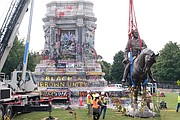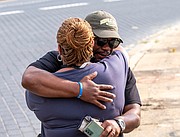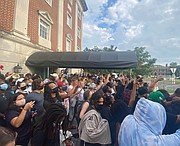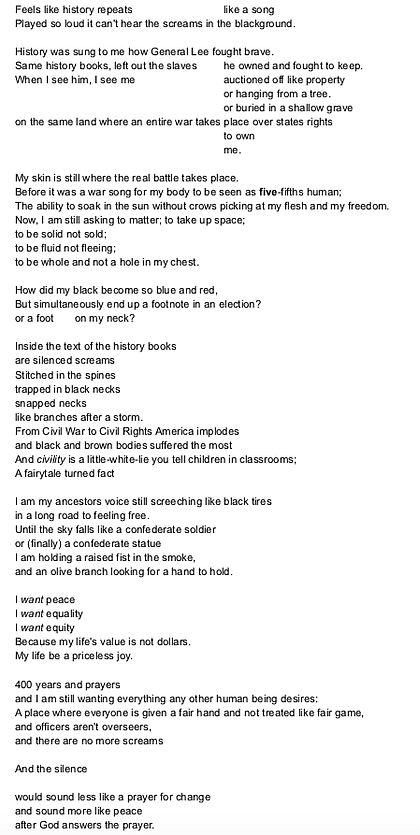From hatred to hope
The 131-year old, 12-ton bronze symbol of white supremacy honoring Confederate Gen. Robert E. Lee on Monument Avenue is taken down as scores watch in person and online
Jeremy M. Lazarus | 9/9/2021, 6 p.m.
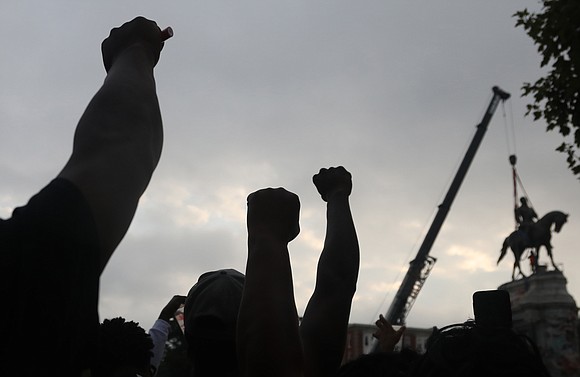
An empty pedestal covered with colorful anti-racist slogans.
That’s all that remains of the state’s greatest symbol of white supremacy – the statue of the traitorous Confederate Gen. Robert E. Lee riding his horse, Traveller.
On Wednesday, after more than a year of legal maneuvering, the 21-foot-tall, 12-ton bronze statue of the slavery-defending Civil War loser was taken down from its perch in a traffic circle at Monument and Allen avenues, where it had seemed to be permanently affixed since 1890.
Who knew it could be so quick and easy?
Cheers and chants of “Na, na, na, na, hey, hey, hey, good-bye,” erupted among the 300 or so people who had gathered to witness a crane lifting the statue from the pedestal and depositing it on the ground in two minutes.
A few years ago, this historic and dramatic change in Richmond’s landscape would have seemed impossible, but there is was—livestreamed to the hundreds of thousands of people who watched via computer and cell phone.
Security was tight, but statue supporters waving Confederate battle flags did not make an appearance.
Workers spent more than an hour preparing to remove the state-owned statue. Taken up in lift buckets, the workers first secured straps around the statue. Then with a brief countdown, the signal was given to lift the statue off the 40-foot-tall base a few minutes before 9 a.m.
Once it was on the ground, the crew spent another 90 minutes cutting through the torso of the general. The two pieces were then loaded on a truck and carted off to an undisclosed secure location where the statue will remain while decisions are made about its future, according to the state Department of General Services.
Aubrey “JaPharii” Jones, organizer of BLM 757, exemplified the emotions that overwhelmed many of the witnesses. He pushed aside the barricades that kept the crowd at a distance and ran around the traffic circle carrying a Black Lives Matter flag before he was quickly escorted off by police.
“This is a proud day for our city and our state,” said computer programmer Carl Cheatham, 62. “This symbol of hatred and oppression is now gone.”
Richmond radio talk show host Gary Flowers, 58, described it as “a day of Jubilee,” in a Biblical reference to what he said Black people call “a great getting up morning of freedom. The removal of Confederate symbols and iconography alleves the spirits of my ancestors who were brutalized by the system those traitors sought to preserve.”
This can’t be all: ‘A paradigm shift must occur’, by George Copeland Jr.
Cheers, chants and singing echoed across Monument Avenue early Wednesday morning as a few hundred people gathered to watch the removal of the Robert E. Lee statue from the perch where it has stood over the city for more than a century.
For the crowd, which ranged from college-age to senior citizens, this was history in the making, with a palpable enthusiasm for Richmond’s future.
“All of this is a historic moment, and we shouldn’t stop here” said Muhammad Abdul-Rahman, an organizer with Richmond New Mainstream, who rallied the crowd by leading chants.
“The people united will never be divided!” some chanted. And they sang, “Hey, hey, hey, goodbye.”
Not a single person waving a Confederate flag was seen.
There was a more uniform sense of purpose among Wednesday’s spectators compared to July 2020 when other monuments to the Lost Cause were taken down.
Some people waved Black Lives Matter flags and there was a sign that put it simply and plainly: “F--- These Statues.”
And while the crowd, which was kept at a distance, had to move to opposite ends of the street to see the statue’s removal through the trees, it did little to dampen the enthusiasm when the 12-ton bronze statue was finally lifted from its pedestal.
The work to remove and disassemble the statue for storage was overseen by Team Henry Enterprises, led by Devon Henry, a Black executive who has faced death threats after his company’s role in removing Richmond’s other Confederate statues was made public last year. He told the Associated Press the Lee statue posed the most complex challenge.
“It won’t transport in this height, so we need to lift the rider off the horse and transport it that way,” Mr. Henry said. “From a thickness standpoint, we don’t know how long it will take. Are there iron supports? It’s a total mystery.”
By mid-afternoon, the pieces of the statue were gone, hauled away on a flatbed truck to cheers from the remaining crowd.
The only moment of conflict came from a brief argument between local anti-Confederate residents and Aubrey “JaPharii” Jones of Black Lives Matter 757, who managed to get into the fenced-off work area and was escorted out by police. BLM 757 is an independent group that has been disavowed by other BLM organizations and criticized for its association with far-right groups.
Beyond that moment, the mood was calm enough for casual communion and creativity, whether it was Washington, D.C., native Tim Smith creating an art piece based on the statue’s removal as he sat in the median or media representatives from as far as Japan interviewing people in the crowd.
From local politicians to out of state visitors, those who spoke to the Free Press shared a common consensus: The statue’s removal is a symbolic step toward progress and greater positive changes in Richmond.
“I hope this is not the end,” said Elise Fuller, a consultant who attended the event with her mother, Lisa. “I think there are a lot of things that we can continue to do. I think this is a tangible change, but there are other changes that need to be made within the community to make sure that this is just the beginning.”
What that next step should look like ranged greatly among the people, from addressing the other Lost Cause aspects of Monument Avenue to focusing on less obvious disparities within the city.
This diversity in opinion extended to the future use of the Lee statue site, with suggestions ranging from converting it into a park or leaving in place the graffiti that has covered the pedestal since mid-2020. Nonetheless, all returned to the importance of using the statue’s removal to push for further change and progress in Richmond
“It’s just a step in the right direction,” said Richmond City Councilman Michael Jones, 9th District. “It’s a symbolic gesture. And so now we’ve got to do the real work to make the city what it needs to be.”
Mr. Abdul-Rahman was optimistic about the possibility of Richmond now tackling other critical matters such as affordable housing, police shootings and equity in city services. This would ensure a “consistent, real democracy” in the city, as he put it, one that didn’t prioritize certain areas and communities at the expense of those less fortunate.
Artist Ra-Twoine Shameel “Rosetta” Fields had a different outlook. With an African flag draped over his shoulders, he pointed out the lack of meaning the Lee statue’s removal would hold for people and communities that have been largely excluded from places like Monument Avenue as they struggle with more systemic problems.
While Mr. Fields acknowledged the statue’s removal as a big moment for the city, he also stressed the need to see the same interest and activity from the public and city officials around other issues. Richmond’s underserved communities don’t get the same attention, he said.
“It’s just a symbol. It’s a placebo pill,” Mr. Fields said of the statue’s removal. “After we take it, we’re still going to be hurting. This trauma, there’s still healing that needs to happen. There’s still change that needs to happen. There’s still a paradigm shift that must occur, and this just can’t be it.”
This was a day that Raymond H. Boone, the late publisher and editor of the Richmond Free Press, would have reveled in. He was outspoken about the Confederate symbols that he said “littered the city” and the mindset that he believed made it far more difficult for Black businesses and Black members of the community to succeed. He routinely called for the statues, symbols of oppression for Black people, to come down.
“Any remnant like this that glorifies the lost cause of the Civil War, it needs to come down,” said Gov. Ralph S. Northam, who had ordered the statue’s removal in June 2020 amid large and continuous racial justice demonstrations in Richmond stemming from the police killing of George Floyd in Minneapolis. The governor’s removal order ended up tangled in a legal fight that finally ended last week in complete victory.
On hand Wednesday for the removal with First Lady Pamela Northam, the governor called it “a great day for Virginia, and hopefully the start of a new era.” He said the statue represented “more than 400 years of history that we should not be proud of” — referencing the racism that had become ingrained among Caucasians since the arrival of the first Black people on a slave ship in 1619. The statue also was a constant reminder of the birth of new oppressive measures that resulted in the full-blown racial segregation of society.
For Gov. Northam, this was another opportunity to continue his efforts toward racial equity as he pledged to do after he was nearly forced to resign from office in February 2019 after a photo publicly circulated from his 1984 medical school yearbook page that featured a picture of a person in blackface and another in a Ku Klux Klan hood and robes.
The statue’s removal was particularly poignant for Richmonder Carmen F. Foster, who viewed it from the street with her son, Dr. Kenneth W. Foster, and 6-year-old grandson, Xavier Foster. A public historian and leadership coach, Dr. Carmen Foster called it a “full-circle experience” for her family. When the statue went up 131 years ago, her once enslaved great-grandfather Jack Foster, who had been a body servant for Confederate Col. Christopher Tompkins during the Civil War, was still alive, while her grandfather, Christopher Foster, was 10.
Like many at the event, she sees the removal as turning a page while still leaving many chapters to complete.
“While it is significant to dismantle symbols of white supremacy,” Dr. Foster commented after the event, “there is much work for communities to do to transform hearts and minds and overcome the vestiges of systematic racism if we are to honor the humanity of all.”
Blaine Lay, 38, of the Richmond Christian Leadership Initiative, agreed.
“The question I have been reflecting on is where do we go from here,” Mr. Lay said. “This is important, but I think there are a lot of other issues around housing, education and other things. This a really good chapter to close, but there are other chapters to be written. I heard someone say, ‘Now is when the work begins,’ and I think that is right.”
Richmond City Councilman Michael J. Jones, who began the effort four years ago to remove Confederate statues in the city following the death of Heather Heyer during the August 2017 white supremacists protest over Confederate statue removals in Charlottesville, said he felt similarly. He called the removal a step in the direction of building “a more inclusive and welcoming city. There is far more work still to be done.”
“This is a good day,” said Ben Ragsdale, coordinator of the Virginia Civil Rights Movement Video Initiative. “But it’s no substitute for real responsibility, repair and reparations that will sustain families and advance generations to the middle class and beyond. Today does not absolve Richmond’s leaders, in both public and private sectors, of this solemn obligation,” he said.
Reginald Carter, a 32-year-old state employee, said the statue’s removal should inspire increased activism. “If it is possible to take down what arguably is the largest Confederate statue in the country, then anything is possible. No longer can we listen to those who say the status quo is how things have always been and this is the way things will always be. Now is the time to speak up and get real change.”
The takedown followed a Sept. 2 Virginia Supreme Court decision that finally cleared the way. On Sept. 2, the state’s highest court, after months of dawdling, unanimously agreed with state Attorney General Mark R. Herring’s legal team that there was no merit in two suits that had sought to block the state from removing the statue. Before the ruling, the court refused to remove injunctions judges in Richmond’s Circuit Court had imposed despite rejecting the arguments that statue supporters had mounted.
The statue went up in 1890 and would soon be followed by Jim Crow segregation and a new constitution imposing literacy tests, ballot taxes and other barriers to Black participation in politics and society.
Like Wednesday, the statue drew national coverage when it was erected. Crusading editor John Mitchell Jr., who had used his Richmond Planet newspaper to inveigh against the monument at the time, had predicted that one day the statue that extolled oppression would come down and that a Black person would do it.
Richmond state Sen. Jennifer L. McClellan recalled that prediction, noting that the work was done by Black contractor Devon Henry and his company, Team Henry Enterprises. Mr. Henry said that since last summer, his company has been hired to remove at least 22 Confederate statues.
Despite death threats, he accepted a city contract last summer and took down virtually all of the Richmond-owned Confederate icons, including three statues on Monument Avenue of Matthew Fontaine Maury and Confederate Gens. Thomas J. “Stonewall” Jackson and J.E.B. Stuart. Protesters had toppled a fourth statue of Confederate President Jefferson Davis on Monument Avenue. The only statue still standing on once whites-only Monument Avenue, ironically, is that of a Black Richmond hero, tennis great and humanitarian Arthur Ashe Jr.
The General Assembly, which has swung from Republican to Democratic control, aided the process last year by overhauling a state law that had barred localities from removing Confederate statues to authorizing them to do so.
The removal of the Lee statue gained national attention given the statue was a significant feature of a city that had served as the capital of the Confederacy during the Civil War that Union forces, under President Abraham Lincoln, finally won.
The Lee statue went up 25 years after the Civil War ended and was a creation of supporters of the ideology of the “Lost Cause,” which sought to present a false narrative about the nobility of the failed effort to rip apart the union to create a society built on slavery, historical records show.
One Confederate statue remains in Richmond — that of Gen. A.P. Hill at the intersection of Laburnum Avenue and Hermitage Road in North Side — and stone markers to Confederate units have yet to be removed from the Manchester Courthouse in South Side.
Gov. Northam has tasked the Virginia Museum of Fine Arts with leading a community-based effort to reimagine Monument Avenue, lay out a vision for the future of the stone pedestal and make recommendations for replacement statues. City Hall and its planning arms, as well as City Council, have called for removal of the pedestals that remain but, as yet, no steps have been taken.
The governor also directed the removal of the time capsule that was installed in the Lee statue pedestal in 1887, three years before the actual sculpture was completed and installed. On Thursday, Sept. 9, a new time capsule will be put in its place. The new capsule has been created by Richmond sculptor Paul DiPasquale, who also made the Arthur Ashe statue. A photo taken of a Black ballerina at the monument last summer, a COVID- 19 vaccination card, a face mask, a Black Lives Matter sticker, a poem written in Unified English Braille and Kente cloth are some of the items to be included.
Photographer Mark Ingram, who took the ballerina photograph, said, “I am thrilled to have my print, my piece of history, be included.”

